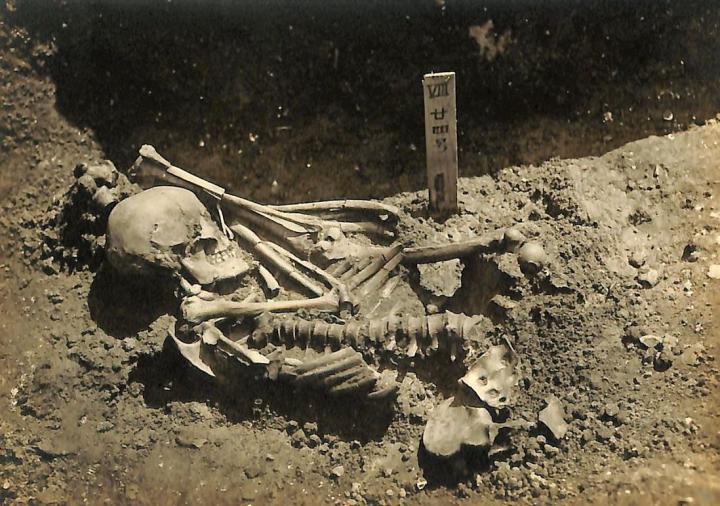Archaeological evidence of shark attack victims is extremely rare, so when the story of a 3,000-year-old Japanese victim was published in 2021, it caught people’s attention. At the time, the victim was thought to be the oldest recorded case of a shark attack victim, but soon after the study was published, other researchers identified what may be an even older case that dates back 6,000 years. So what do we know about these two ancient victims?
Individual No. 24
Around 3,000 years ago, sometime between 1370 and 1010 BCE, a man was fishing in the waters of the Seto Inland Sea of the Japanese archipelago when he was attacked by a large shark. Despite being recovered by his companions, the man suffered serious and extensive injuries. He had at least 790 deep, serrated wounds which were mostly confined to his arms, legs, and the front of his chest and abdomen.
After his death, the individual was buried in his people’s community cemetery, an archaeological site known as the Tsukumo Shell-mound cemetery site, which was excavated in the early 20th century.
For a long time, the man’s remains baffled researchers who could not figure out how someone could receive such extensive and varied injuries from another human using stone tools. Nor could they think of any commonly reported animal that may have been able to produce such marks.
However, further examination of the skeleton as part of a larger project looking into violence in prehistoric Japan gave researchers a new opportunity to explore possible causes. The team, led by J. Alyssa White at the University of Oxford, noted that the lesions on the bones were extremely similar to reports of shark attack victims found on modern and archaeological remains.
Individual No. 24 was found with extensive wounds that suggest he was killed by a large shark, probably a tiger or a white shark.
Image credit: Kyoto University
By working with George Burgess, Director Emeritus of the Florida Program for Shark Research, the team were able to reconstruct a picture of the Japanese individual’s fate. As they said in a statement, “Given the injuries, he was clearly the victim of a shark attack. The man may well have been fishing with companions at the time, since he was recovered quickly. And, based on the character and distribution of the tooth marks, the most likely species responsible was either a tiger or white shark.”
The victim, known as “Individual No. 24” belonged to the Neolithic Jōmon people of Japan, a semi-sedentary culture that lived mostly in pit dwellings arranged around open spaces. They were hunter-gathers, who were known to exploit a range of marine resources.
“It’s not clear if Tsukumo 24 was deliberately targeting sharks or if the shark was attracted by blood or bait from other fish,” co-author Dr Mark Hudson explained. “Either way, this find not only provides a new perspective on ancient Japan, but is also a rare example of archaeologists being able to reconstruct a dramatic episode in the life of a prehistoric community.”
Peru’s ancient victim
Soon after the story of Individual No. 24 broke, two researchers looked back at archaeological work they conducted several decades ago. In 1976, bioarchaeologist Robert Benfer of the University of Missouri, Columbia, and Jeffrey Quilter, an anthropological archaeologist at Harvard University, helped excavate the remains of a teenage boy at a Peruvian village site called Paloma, whose skeleton exhibited marks that appeared consistent with those of a fatal shark attack – his left leg was missing, while his right hip and right forearm showed signs of deep serrated bite marks.
If the boy was attacked by a shark, then the wounds likely occurred as he tried to fend it off, raising his arm to protect him as the animal bit down. Similarly, successful shark bites often involve tearing actions that, when applied to humans, can rip off limbs, especially legs.
According to radiocarbon dating, the boy met his traumatic fate around 6,000 years ago before being buried among his community. If their assessment is correct, this would make the boy the oldest recorded example of a shark attack victim.
The boy’s village was located about 3.5 kilometers (2.2 miles) from the Pacific Coast of Peru. Between 7,800 and 4,000 years ago, various small communities intermittently lived in the area. They, like the Jōmon people of Japan, exploited marine resources to survive, including fishing, diving for shellfish, and gathering plants.
When the boy’s remains were excavated, they were found in a long, oval pit in an open area. His body had ben placed under some sort of covering made of canes tied together with mats. He had several grave items with him, including a seashell, a flat rock, and several ropes.
After the excavation, Quilter described the young man’s injuries in two paragraphs of his book, Life and Death at Paloma, which was published in 1989. The results of this work were never published in any academic journals, so were unknown to White and her colleagues when they were researching Individual No. 24. The researchers have since been in touch, but it is still unclear whether the Peruvian case is definitely an example of a shark attack. Perhaps future research will confirm this tragic but fascinating fate.
[H/T: Science News]
Source Link: What Is The Oldest Known Case Of A Shark Attack Victim?
